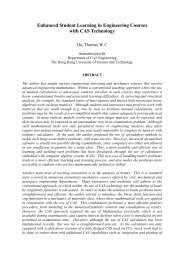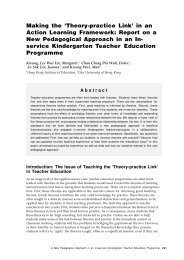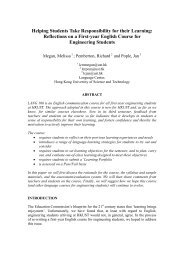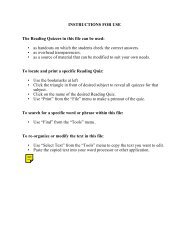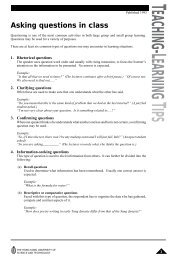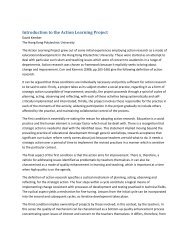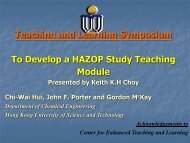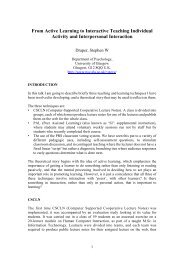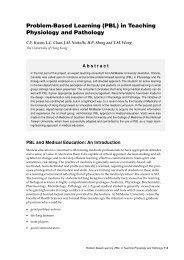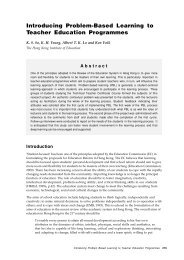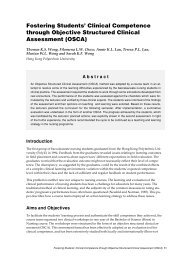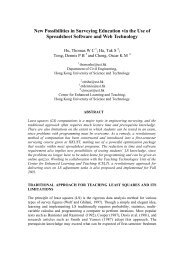Implementing Peer Assessment to Improve Teaching and Learning
Implementing Peer Assessment to Improve Teaching and Learning
Implementing Peer Assessment to Improve Teaching and Learning
Create successful ePaper yourself
Turn your PDF publications into a flip-book with our unique Google optimized e-Paper software.
peer assessment <strong>to</strong> me is only an additional <strong>to</strong>ol <strong>to</strong> supplement any defect for drawback of<br />
what we have done. For example, what the lecturer cannot see is how much every member<br />
has contributed, so we give the lecturer another small bit of the picture<br />
I think it is good <strong>to</strong> make the individual work harder <strong>and</strong> contribute <strong>to</strong> the group work <strong>and</strong><br />
not <strong>to</strong> harm the whole presentation of the group.<br />
Although most of the students generally supported peer assessment, some raised concerns with<br />
regard <strong>to</strong> their ability <strong>to</strong> assess their fellow students, pointing out that they were not professional.<br />
These comments were made mainly by students who participated in peer assessment for the first<br />
time. In addition, those students expressed their concern that the objectivity of their assessment of<br />
others may have been affected by personal relationships with their fellow students.<br />
In my opinion, sometimes that may be a concern if those in my group are my friends. I even<br />
know that I may tend <strong>to</strong> give them higher marks. But for those that I don't know, well, I may<br />
be a little bit more objective.<br />
Students indicated that some practical problems existed in the application of the method. These<br />
were included the insufficient time allocated for group presentation <strong>and</strong> the size of the group<br />
which was regarded as <strong>to</strong>o small:<br />
In general, I think that the method of peer assessment is quite fair, but its function is quite<br />
limited for a small group size...it is much better if the group size is bigger. For example, if<br />
the group has about six <strong>to</strong> even eight members , each member of the group will have a more<br />
objective opinion <strong>to</strong> the other group members because the sample size is greater.<br />
Several suggestions were made concerning the ranking procedure <strong>and</strong> the use of certain criteria:<br />
Maybe give a mark <strong>to</strong>tal rather than a mark on every criterion, because everyone’s strength<br />
is different.<br />
I think that the criteria could be developed with the students, although it will depend on the<br />
maturity of the students.<br />
Second Cycle<br />
Plan<br />
Students’ suggestions were considered in the second cycle of action learning. Plans were made <strong>to</strong><br />
involve students in setting the criteria for the peer assessment <strong>and</strong> <strong>to</strong> enlarge the group size.<br />
Act<br />
The second cycle was held during the second semester in the elective subject of ‘Effective Communication’,<br />
which was attended by some students who participated in the first cycle. In this cycle<br />
students were briefed on the method <strong>and</strong> two sessions were dedicated <strong>to</strong> establishing the criteria.<br />
The lecturer shared with the students the previous experience of peer assessment including student<br />
feedback <strong>and</strong> solicited their views on setting the criteria for assessing their classmates. After<br />
brains<strong>to</strong>rming in class, the students arrived at an agreeable set of criteria for assessing the group<br />
presentations. The criteria set by the students included the organisation of the presentation <strong>and</strong> its<br />
relevance <strong>to</strong> the theme under investigation <strong>and</strong> <strong>to</strong> the teacher’s job. Clarity, interaction, timekeeping<br />
<strong>and</strong> presenting in an interesting way were also criteria set by the students.<br />
As for the group size, students could form groups with no limit <strong>to</strong> the size. As a result, there was<br />
one group which consisted of six members.<br />
20 <strong>Assessment</strong>



